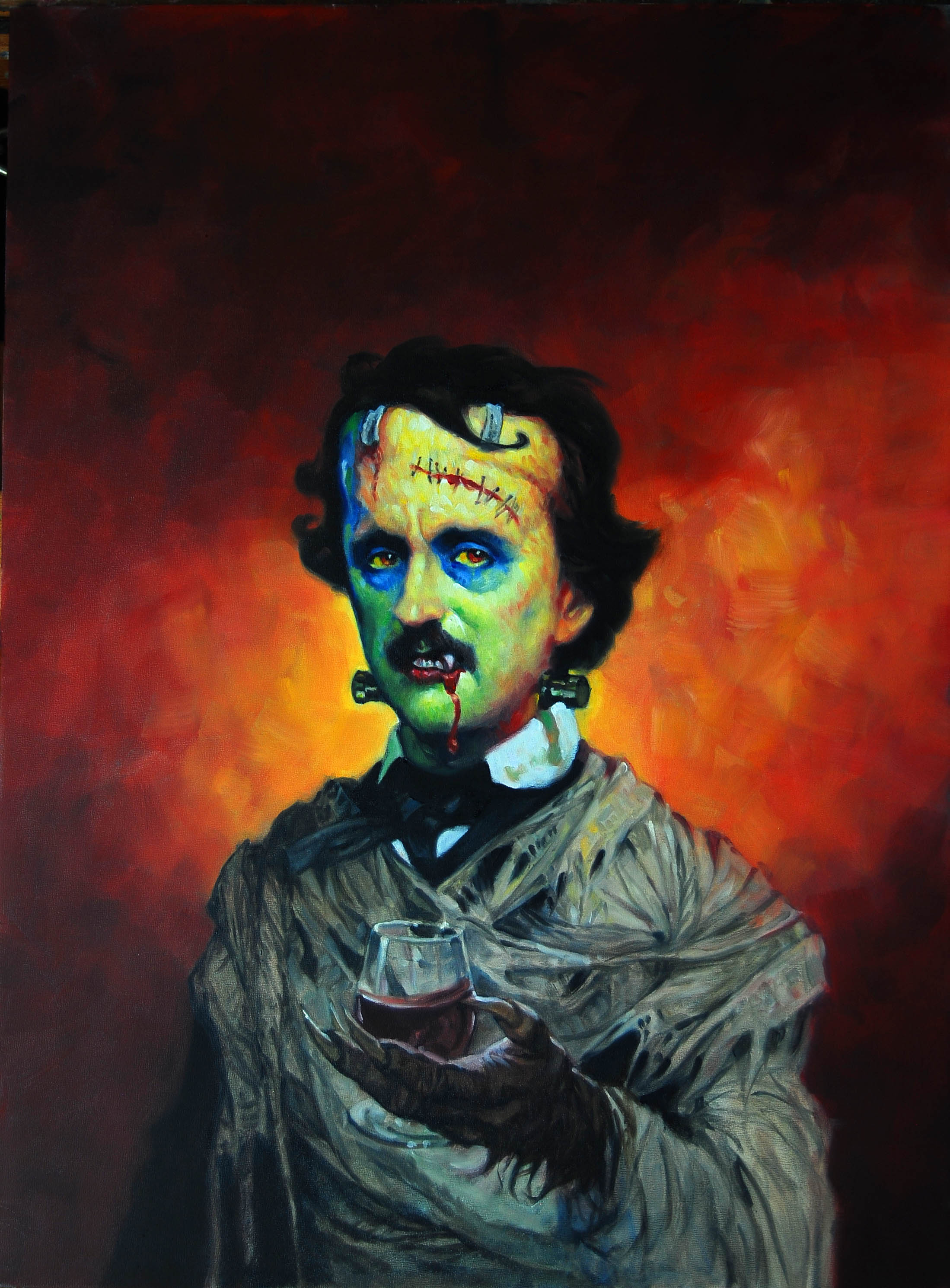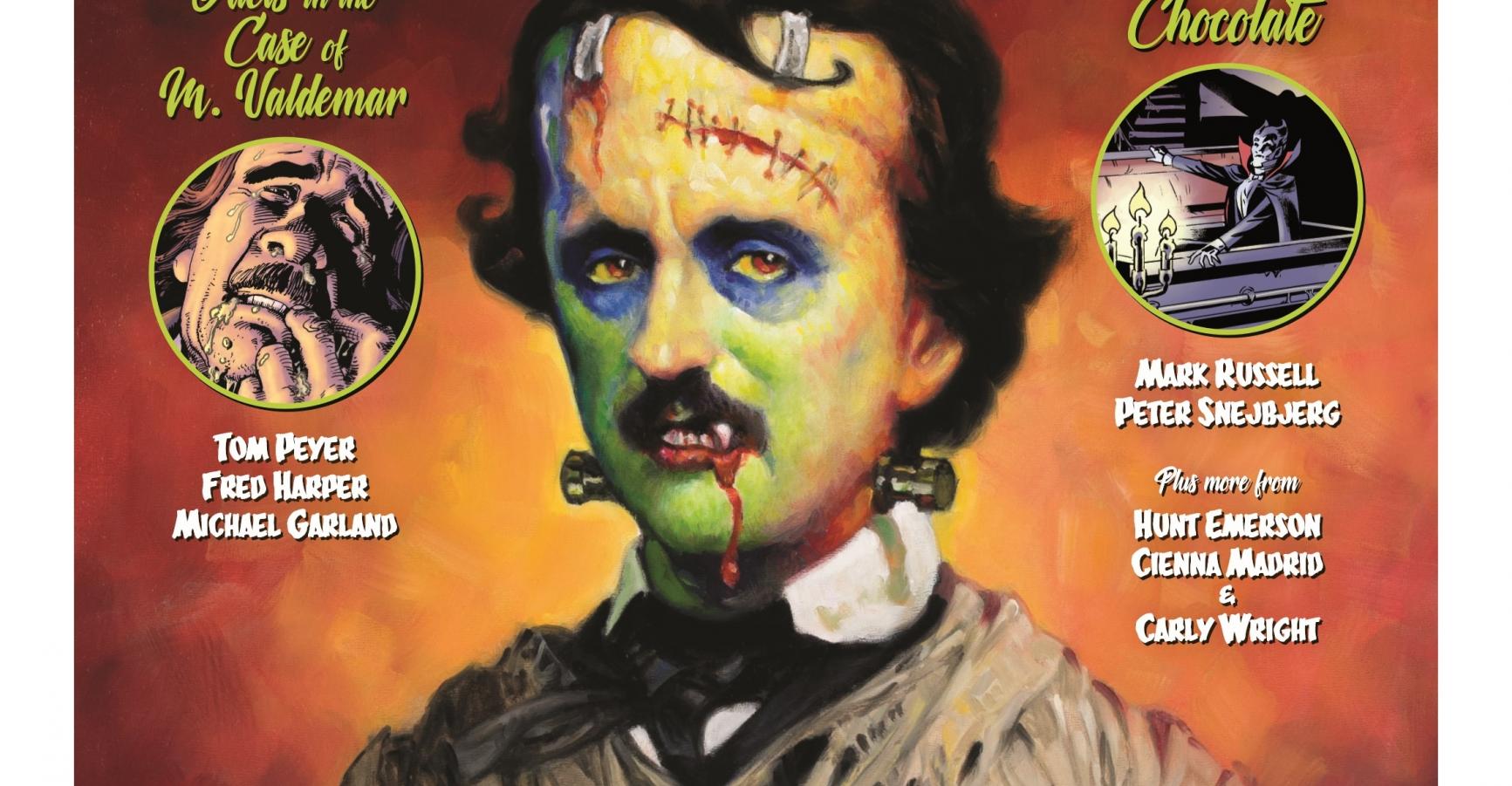For more than 30 years, artist Richard Williams has been messing with American culture, most notably on the covers of MAD. His client list includes NBC, Hallmark Cards, The Atlantic, Forbes, and the National Park Service. Williams’ paintings have been purchased by Steven Spielberg, George Lucas, and Howard Stern.
Through old-fashioned intimidation and coercion, the AHOY Comics brain trust convinced Williams—a fellow Syracusan—that it was in his best interests to paint covers for HIGH HEAVEN and EDGAR ALLAN POE’S SNIFTER OF TERROR. He also agreed to meet with publisher Hart Seely in a public parking lot to discuss his career.
Okay, I think this recorder is working. So, how did you get a job with MAD?
It was through my agent in New York City. I didn’t seek it out. I had never really read the magazine that much as a kid. My parents would tell me, “Don’t read that! Don’t waste money on it!” I’d been doing illustrations for a year or two, and my agent said, “MAD wants a cover.” I was reluctant, actually tried to find excuses not to do it. Turns out, it was the start of a beautiful friendship.
What was that first cover?
It was a painting of Star Wars with Mr. T as Darth Vader, pulling off his helmet. They loved it. Everything went from there.
How many times in your life do you think you’ve drawn Alfred E. Neuman?
Oh, God! I can draw him in my sleep. I can’t count the times. The variations, the sketches? Hundreds and hundreds of times. For a while in the eighties, I was doing just about every cover. It was quite a bit.
What’s the craziest Alfred E. you ever drew?
Another hard one. I can say there were some that I didn’t enjoy doing, that I didn’t think were all that good, but it’s hard to put my finger on one in particular. There are so many. Sometimes, I look at my old paintings and I think, “Wait a minute… did I paint that?” Maybe I should cut back on the alcohol.
Ever get blowback from a cover?
Occasionally, some reader would write in to say they were really offended. “How dare you!” and “You should know better!” and sometimes a little “Burn in hell!” That kind of stuff. Not often. Just a few times.
Did you explain that you’re just the painter?
MAD would handle those things. People would comment to the editors, and they would act as the buffer. They would never let those people know where we live, so they couldn’t contact us. They were aware of the need for that.
I mean, with their humor, going back to the 1950s, they dealt with many lawsuits over many things. At one point they were accused of being a communist front. They were used to everything. And for a number of years, they were probably the most radical magazine in America; the other closest would be Playboy. You just didn’t have many magazines that questioned an entire culture. MAD was unique in that way. So, yeah, we caught flack now and then, but they knew how to handle it, and how to protect their writers and artists.
What was it like working with AHOY?
Umm? Well… um… I’m enjoying it. You guys are easy to work with. I mean, some clients I’ve had—
WAIT! I goofed. I meant MAD. Not AHOY. What’s it like working for Mad?
Yeah, I was sort of wondering…
But thank you for sucking up.
Yeah, it was like, “And how do you like my hat?” Well, “Yes, it’s a great hat! I wish I had a hat like that!”
I meant to ask, what it was like working for MAD.
At first, I was hesitant because, you know, I wanted to be this “serious” illustrator. And here I was, doing things for a humor magazine. But after I got to know the people at MAD, it was great. They were fun. They were crazy. I came to realize they had much of the same humor that I did. And they were also nice. I mean, they could be particular: they’d want this or that, and your work had to be exactly right. But they always stuck up for me. They gave me the benefit of the doubt.
I’ve worked for a lot of publishers in New York City, and some of them are just frickin’ assholes – I mean, just miserable to work for. Hateful. When you finished a job, you’d tell yourself, “I hope they never call me again.” But with MAD, you looked forward to the next one. They’d take me out to lunch, and we’d have a great time. We were able to combine a sense of business with that crazy sense of humor. So, yeah, I liked working with them a lot.
With AHOY you’ve done covers for EDGAR ALLAN POE’S SNIFTER OF TERROR…
And I want to say, I JUST LOVE AHOY!
Each Poe cover is different.
Yes! And I LOVE AHOY!
Tell me about the first Poe cover. (AHOY Editor-In-Chief) Tom Peyer had an idea, and you put it into paint.
When you work with someone, and you see things the same way they do, it’s great. It’s not like they’re saying, “Okay, we’re doing this romance novel, and we need Fabio on the cover!” stuff like that, where you think, “Oh, God,” because you’ve already done this a million times. With these Poe covers, you think, “This is an actual cool idea!” With these covers, they’re always an interesting challenge. It’s how can I do it. I have two photographs of Poe.
So, how can I make it work? And the ideas are crazy. But you guys don’t say, “No, we can’t do this.” You guys say, “Hey, let’s try!” And it works.
On issue number 2, there is a cover that I call “Attack of the 50 Foot Poe.” When Peyer proposed it, did you think that would work?
I was a little worried. I was thinking, “I’ve got to paint all these little cars. Can I get it done in time?” But that focuses you. You think, I’ll just have to pull an all-nighter if necessary. But I’m going to get it done. So, the Poe cover, as soon as you guys suggested it, I could see it. You could just see his face, and it works.
So, then we decided to do a Jaws parody, and I just went with it. That’s what I like to do.
Shoot. It’s starting to rain. Let’s get into the car. This recorder seems to be working.
Shouldn’t we see a light? You think it’s on?
Hold on. I’ll we’ll see if it’s wor—
[BREAK IN TAPE]
—it’s on, and I think it’s working.
There’s no light on it.
Hmm. Where is the… let me tur—
[BREAK IN TAPE]
—is working. We have tested it, and it’s working.
There was a light that was on. It’s not on.
[BREAK IN TAPE]
Okay, it’s working! Okay? You know, when I was a reporter, during the Bush-Gore presidential race, I taped a bunch of panel discussions. I did doctors, factory workers, all types. For the last one, I got three stand-up comics from a local comedy club. We met at a Denny’s. They were hilarious. Best panel I’d ever done. Driving home, I realized that nothing had recorded. I was screaming into the windshield. So, I pleaded with them, and they agreed to a second sit-down. Five minutes in, they started mocking me. For the rest of it, every question, they just ripped me up. Relentless.
Wow.
Worst part? The readers loved it. They loved it.
Ouch.
So, I never trust these things. But I think it’s working. So, when you tell people you paint comics, is there a stigma attached?
Thirty years ago, I would have said yes. It was the same thing with MAD. I wanted to be a “serious” illustrator. But when I look at comics today – especially when I saw the HIGH HEAVEN story line—I just thought, “Shit, this is cool.” I like the story. And when you think about it, and you look at the young people I teach (Onondaga Community College and Le Moyne College), this is what they are all about.
Look, they’re not reading Tolsoy. They’re reading comic books. When I was a kid, a comic book was not considered a major source of communication. It was fun, but trivial. Nothing more. Now, it is the graphic novel. It is where people get information.
Now, when I look at comic books, I see them entirely differently. I’m studying the covers, looking at the art, getting books on them, and I’m thinking, “Why does this work?” and, “Why didn’t this work?” I’ve even started playing with the idea: Maybe I could do a comic book. That would be fun. How could I do it? What would be the process? And what kind of story would I have?
Want to try a short one for AHOY?
Not at this point. I’ve got a lot to learn.
Yeah, it’s not easy.
I was working with a friend, who had a book he was trying to get published, and I said, let me try it as a graphic novel. So, I started working up one chapter, getting it out. And believe me, it is frickin’ hard. Really hard. You have to think, how much of this panel is to be leading into the next thing—
You have to know how to land a knockout punch.
Exactly! Where is that knockout punch going to hit? I sketched it out through the first chapter, but it’s tough. With cover art, it’s a one-panel story. For this, it’s a whole different way of sequencing, of pacing, where will the knockout punch come? How much is the leadup? I’m not sure of myself yet. But I would love to try sometime down the road.
We could have you do a three-pager. You never know.
Absolutely! It could be a complete failure! I’m going to work on one and get a critique on the things I’ve got to improve. I need to do that first. Because I hate to fail.
Then you’re in with the wrong crowd. But getting back to comics, you’re definitely not a comic book guy. You can’t, like Peyer can, tell me what happened in issue #126 of The Flash? (Mirror Master turned him into a mirror—Ed.)
No. Absolutely not. But growing up, I had friends who could. They followed The Hulk. It was Marvel against DC., and to them, Marvel was better, DC. was terrible, things like that. They’d explain it to me, and I’d be going, “Huh, okay, whatever, I’m going home to masturbate.” WAIT… I shouldn’t have said that. This recorder isn’t working, right?
Probably not.
Well, I think comics have changed a lot. They have really improved. You see these comic book artists—like David Finch!—just marvelous artists! Such a sense of composition, you look at it and just think, holy crap! This is great stuff!
The melding of a great writer and artist is something to see.
Absolutely. I was listening to a presentation from a guy from Virgin Comics—he was talking about how comics’ influence has spread to India and Asia. He said people from little villages didn’t have the resources to come to the cities, so they’d load up trucks and take comics to the villages. They would get artists off the streets of Bombay, put them in rooms with computers, and they do the whole thing. They were connected with Chinese and Japanese directors to use the comic books as a means to promote future movies. They would bring in elements of Asian mythology, maybe have a superhero from some Asian god. It’s amazing how this phenomenon, which was once unique to the United States, has traveled around the world.
A question I always ask: Which superhero do you think would be the biggest asshole to work for, up close?
Hmm. Well, you figure these action heroes, running around in their polyester suits, they have to get really sweaty, and they must smell really bad. So, I wouldn’t want to work closely with any of them.
You know, I’ve never thought of that. Okay, are you ready for having people ask what is your favorite Poe story?
I’m terrified of that. He’s someone I never read. I know it’s terrible. I have friends who love Edgar Allan Poe. They quote their favorite stories to me. One, when he saw the first painting I did, said, “Won’t you come over, I have ‘Cask of Amontillado’ and I’d love your opinion of it.”
We still don’t know how these books will go over with Poe fans.
I know. I love other Gothic writers, but Poe just never did it for me. I don’t know why. When they ask for my favorite Poe story, I will be at a loss.
That could be trouble.
I better start reading.
Or come up with a cool answer.
I know: I’ll say, the one he wrote with Vincent Price!








